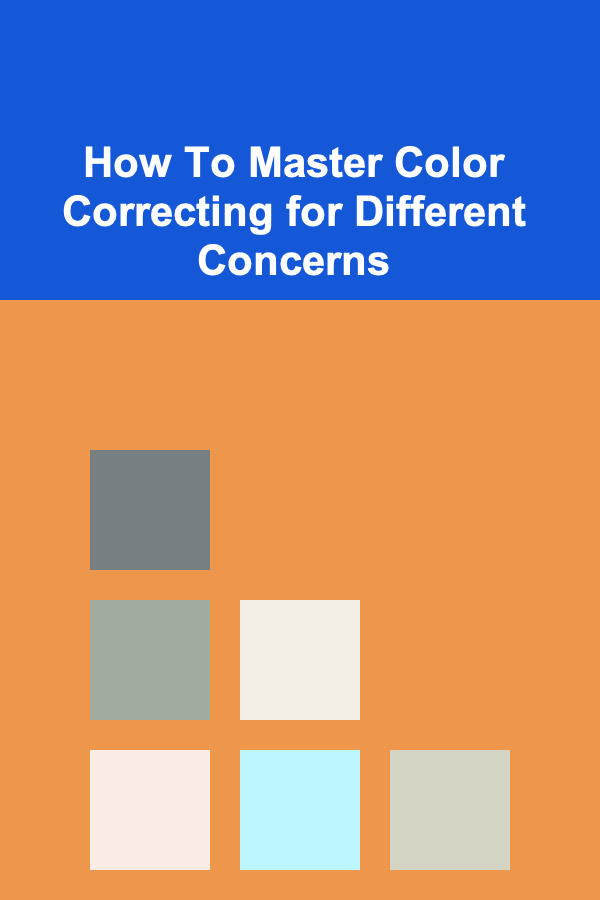
How To Master Color Correcting for Different Concerns
ebook include PDF & Audio bundle (Micro Guide)
$12.99$7.99
Limited Time Offer! Order within the next:

Color correcting is a powerful tool in the world of makeup, skincare, and photography. It involves using colors opposite on the color wheel to neutralize certain undertones or imperfections on the skin, creating a more even and flawless appearance. Whether you're dealing with redness, dark circles, hyperpigmentation, or dullness, mastering color correction can significantly improve the final look and give you more control over your complexion.
In this article, we will delve into the science behind color correction, the different types of color correcting products, and how to effectively use them to address specific skin concerns. Whether you are a makeup artist or a beginner exploring color correction techniques, this guide will provide you with the tools and knowledge to master color correction for a flawless finish.
Understanding the Color Wheel
The key to successful color correction lies in understanding the color wheel and how colors interact with each other. The color wheel is a circle that shows the relationships between different colors. The most important thing to know is that colors opposite each other on the wheel are considered complementary. When you place a complementary color over a color you want to neutralize, it cancels out the unwanted tone.
For instance, if you have redness in your skin, you would use a green corrector because green is opposite red on the color wheel, which means it neutralizes the red tones. Similarly, if you have dark circles under your eyes, orange or peach tones work well to cancel out blue or purple undertones.
Here are the basic complementary color pairs you need to know:
- Red and Green: Green neutralizes red tones, making it effective for correcting acne, rosacea, or any other redness.
- Blue and Orange: Orange neutralizes blue tones, which is ideal for concealing dark circles, veins, and bruises.
- Purple and Yellow: Yellow neutralizes purple tones, making it useful for correcting dark under-eye circles, bruises, or hyperpigmentation.
- Peach/Orange and Blue: Peach or orange tones neutralize blue tones, helping with correcting dark under-eye circles in deeper skin tones.
Now, let's break down how to use these colors effectively for various skin concerns.
Redness and Rosacea: Using Green Correctors
Redness is one of the most common skin concerns, whether due to rosacea, acne, or irritation. Redness can be caused by several factors such as inflammation, broken capillaries, or sensitivity. To combat this, green color correctors are often the go-to choice.
Green is opposite red on the color wheel, so it effectively cancels out redness when applied to the affected areas. When using a green corrector, it's important to apply it only to the areas that need correction, such as around the nose, cheeks, or chin.
How to Use Green Correctors:
- Apply the green color corrector to areas of redness using a light hand. Make sure to blend the product in well with a brush or sponge to avoid a harsh line of green.
- Layer your foundation on top of the green corrector. The foundation will help further blend the color and create an even base.
- Avoid using too much. A small amount of green is usually enough to neutralize redness. Too much can make your complexion look uneven.
Green correctors are available in various formats, including creams, sticks, or liquids, so it's best to choose a formula that suits your skin type. If you have oily skin, opt for a more mattifying formula, while dry skin might benefit from a hydrating green corrector.
Dark Circles and Under-eye Concerns: Using Orange, Peach, and Yellow Correctors
Dark circles are a widespread concern, often caused by lack of sleep, genetics, or aging. They can range in color from bluish or purple to brownish, depending on your skin tone and the cause. The goal with color correction for dark circles is to neutralize the blue or purple undertones, and the best way to do this is by using orange or peach tones.
Peach and orange shades are great for those with fair to medium skin tones, while deeper skin tones often benefit from richer orange or red undertones. Yellow correctors can also work well for brightening the under-eye area, particularly for those with yellow or olive undertones.
How to Use Orange/Peach Correctors:
- Apply a small amount of the corrector under your eyes, focusing on the darkest areas.
- Blend the product using a beauty sponge or your fingers until the orange tone is no longer visible. The goal is to neutralize the purple tones without creating an orange tint.
- Follow with a concealer that matches your skin tone. This helps to further balance the area and cover any remaining discoloration.
Yellow correctors can be used as a final step to brighten the under-eye area. Apply it over the peach or orange corrector for an added lightening effect. Make sure to set everything in place with a light dusting of translucent powder to avoid creasing and ensure the correction lasts throughout the day.
Hyperpigmentation and Dark Spots: Using Red and Purple Correctors
Hyperpigmentation is another common concern, often resulting from acne scars, sun damage, or hormonal changes. These dark spots appear as brown, purple, or red patches on the skin, and to neutralize them, the right color correction technique is essential.
For red or pink-toned hyperpigmentation , a green corrector can be helpful, as discussed earlier. However, for brown or dark spots, you will want to use red or purple-based correctors, depending on the undertone of the pigmentation.
- Red pigmentation: Use a green corrector to neutralize the redness.
- Purple pigmentation: Use a yellow or peach-based corrector.
- Brown pigmentation: Use a red or orange corrector.
How to Use Red/Purple Correctors:
- Dot the corrector on the pigmented areas and blend gently with a brush or sponge.
- Avoid applying too much product, as it can make the skin look too color-blocked. Instead, aim to neutralize the pigment while keeping the overall skin tone natural.
- Layer foundation on top of the corrected area to ensure a flawless finish.
For deep pigmentation, such as dark spots or melasma, you may need to use a combination of color correctors to get the best result. Start with a color that neutralizes the base tone of the discoloration (green for redness, yellow/peach for dark circles, red for brown spots), and then follow with your foundation.
Dullness and Lack of Brightness: Using Yellow and Pink Correctors
If your skin looks tired or dull, color correction can help add vibrancy and brightness to your complexion. The key to correcting dullness is using yellow or pink tones to warm up the skin and create a radiant, glowing appearance.
Yellow correctors are ideal for those with cooler undertones or those dealing with a lack of brightness in the skin. Pink correctors are great for adding warmth and radiance, especially for those with fair to light skin tones.
How to Use Yellow/Pink Correctors:
- Apply the yellow or pink corrector to areas of your face that need brightening. Focus on the under-eye area, the high points of the cheeks, and the forehead.
- Blend it well using a beauty sponge to ensure the color is seamlessly integrated into your skin.
- Follow with your foundation and concealer to even out the overall complexion.
Yellow correctors are also excellent for brightening the under-eye area and correcting sallow or tired-looking skin. Pink correctors, on the other hand, add a youthful flush of color to the face, counteracting any signs of dullness and fatigue.
Acne and Blemishes: Using Green and Lavender Correctors
Acne and blemishes can cause both redness and texture problems on the skin. The key to concealing blemishes is using green for redness and sometimes lavender to counteract yellow or sallow tones. Lavender works especially well for those with fair to medium skin tones who need to neutralize dullness and promote a more even skin tone.
How to Use Green and Lavender Correctors:
- Apply green corrector directly to the blemishes or acne scars that are inflamed or red.
- Dot lavender or purple corrector on areas of the face that look sallow or dull, like the forehead or under the eyes.
- Blend well using your fingers or a brush, and then follow with a layer of foundation to balance the overall skin tone.
Conclusion
Mastering color correction for different skin concerns is a valuable skill that can help you achieve a flawless complexion. By understanding the science of color theory and how to use complementary colors, you can target specific issues like redness, dark circles, hyperpigmentation, and dullness.
Whether you are a makeup enthusiast, a professional artist, or someone looking to improve their daily routine, color correction provides the tools to address a variety of complexion concerns with precision. As with any makeup technique, practice is key, so don't be afraid to experiment with different color correctors and methods to see what works best for you.
Remember, color correction is about creating harmony in your complexion. With the right products and techniques, you can effectively neutralize imperfections and enhance your natural beauty, one color at a time.
Other Products

How to Bathe Your Pet Properly at Home
Read More
How to Clean and Care for Your Leather Furniture
Read More
How to Provide Mental Stimulation for Your Pet at Home
Read More
How to Soundproof Your Doors and Prevent Noise Leaks
Read More
How to Use Google Analytics to Monitor Traffic from Influencers to Your Dropshipping Store
Read More